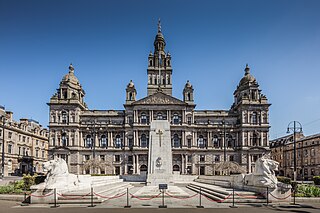
The City Chambers or Municipal Buildings in Glasgow, Scotland, has functioned as the headquarters of Glasgow City Council since 1996, and of preceding forms of municipal government in the city since 1889. It is located on the eastern side of the city's George Square. It is a Category A listed building.
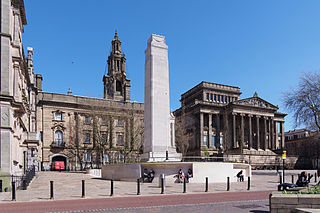
Preston is a city on the north bank of the River Ribble in Lancashire, England. The city is the administrative centre of the county of Lancashire and the wider City of Preston local government district. Preston and its surrounding district obtained city status in 2002, becoming England's 50th city in the 50th year of Queen Elizabeth II's reign. Preston has a population of 114,300, the City of Preston district 132,000 and the Preston Built-up Area 313,322. The Preston Travel To Work Area, in 2011, had a population of 420,661, compared with 354,000 in the previous census.

Preston railway station in Preston, Lancashire, England, is an interchange railway station on the West Coast Main Line, half-way between London Euston and Glasgow Central. It is served by Avanti West Coast, Northern Trains and TransPennine Express services, plus Caledonian Sleeper overnight services between London and Scotland. It is also served by the Calder Valley line to Leeds and York, and by branch lines to Blackpool, Ormskirk, and Colne.
A county hall or shire hall is a common name given to a building that houses the seat of local government for a county.
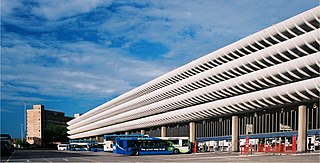
Preston bus station is the central bus station in the city of Preston in Lancashire, England. It was built by Ove Arup and Partners in the Brutalist architectural style between 1968 and 1969, to a design by Keith Ingham and Charles Wilson of Building Design Partnership with E. H. Stazicker.

The Glamorgan Building is a former county hall located at King Edward VII Avenue in Cathays Park, Cardiff, Wales. It was the headquarters of Glamorgan County Council from 1912 to 1974 and then of Mid Glamorgan County Council from 1974 to 1996. The building, which was acquired by Cardiff University in 1997 and is now home to the university's School of Social Sciences and the School of Geography and Planning, is a Grade I listed building.
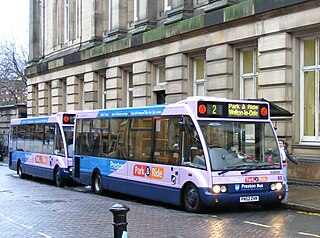
Preston park and ride is a park-and-ride scheme in the city of Preston in Lancashire, England, operated by both Rotala subsidiary Preston Bus and Stagecoach Merseyside & South Lancashire.
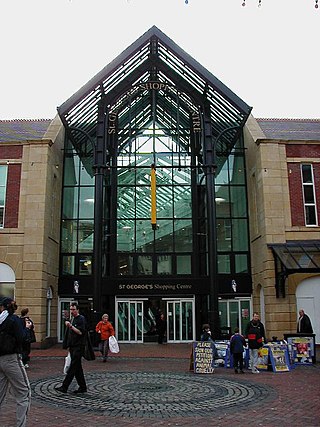
St George's Shopping Centre, formerly The Mall Preston and The Mall St George, is a shopping centre in the city of Preston, Lancashire, England.
James Hibbert was an English architect who practised in Preston, Lancashire.

Gloucester Shire Hall is a municipal building in Westgate Street, Gloucester. The shire hall, which is the main office and the meeting place of Gloucestershire County Council, is a grade II listed building.

Essex County Hall is a municipal building in Market Road, Chelmsford, Essex: it is the headquarters of Essex County Council. Blocks C and D are Grade II listed buildings.

Aylesbury Crown Court, also known as Old County Hall, is a former judicial facility and municipal building in Market Square, Aylesbury, Buckinghamshire, completed in 1740. The building served as the meeting place of Buckinghamshire County Council from 1889 until 2012, and was used as a court until 2018. It is a Grade II* listed building.

County Buildings is a municipal facility at Martin Street in Stafford, Staffordshire. The building, which is the meeting place for Staffordshire County Council, is a Grade II* listed building.
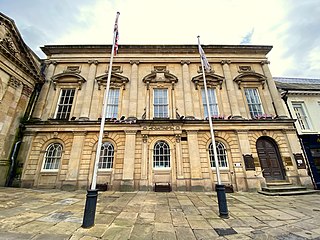
The County Hall is a municipal facility on George Row in Northampton, Northamptonshire, England, which was the headquarters of Northamptonshire County Council until it was dissolved in 2021. It is a Grade II* listed building. The building is adjacent to the former Sessions House which is now used as a Tourist Information Centre.

County Hall is a municipal building on New Road in Oxford, Oxfordshire, England. County Hall, which is the headquarters of Oxfordshire County Council, is a Grade II* listed building.

Shirehall is a municipal facility in Abbey Foregate, Shrewsbury, Shropshire. The building, which is the headquarters of Shropshire Council, is just north of Lord Hill's Column.

County Hall is a municipal facility at Raikes Lane in Mold, Flintshire. It was the headquarters of the old Flintshire County Council from 1967 to 1974, the headquarters of Clwyd County Council from 1974 to 1996 and has been the headquarters of the new Flintshire County Council since 1996.
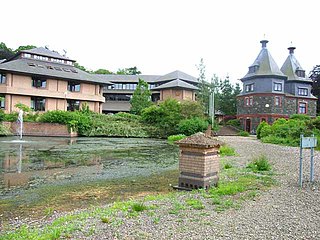
County Hall is a municipal building in Llandrindod Wells, Wales. It is the headquarters of Powys County Council.

Chorley Town Hall is a municipal building in Market Street in Chorley, Lancashire, England.

Preston Town Hall is a municipal building in Lancaster Road in Preston, Lancashire, England. The town hall, which is the headquarters of Preston City Council, is a Grade II listed building.






















